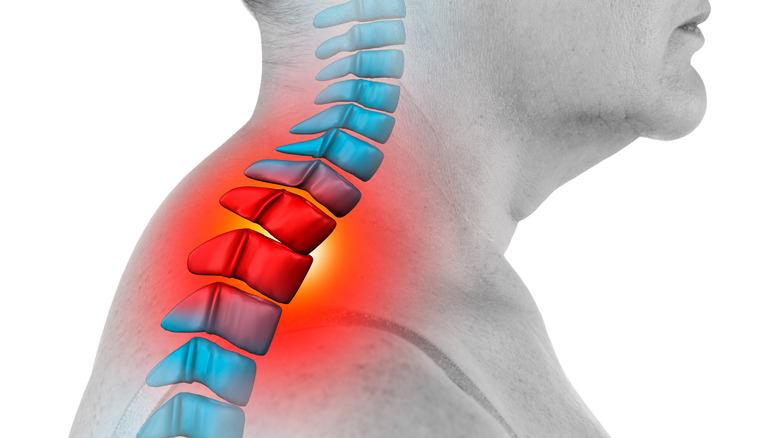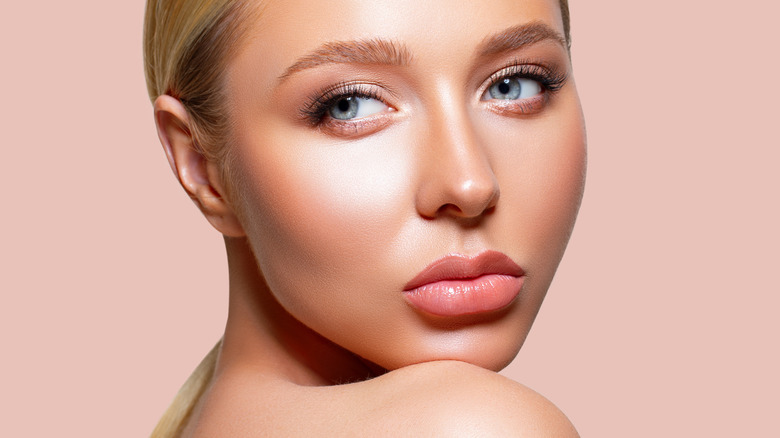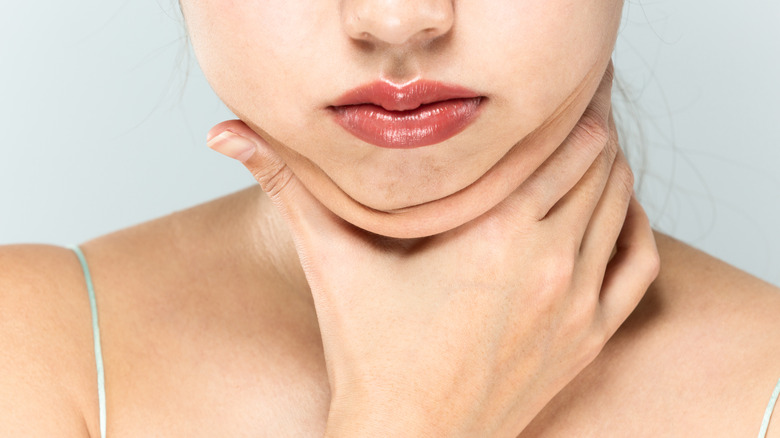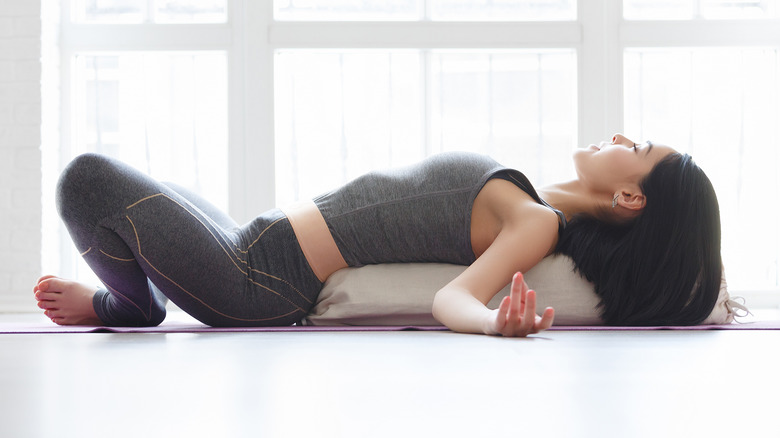How To Get Rid Of That Buffalo Hump At The Base Of Your Neck
Seven vertebrae make up the neck area of the spine called the cervical spine (via Cleveland Clinic). Some people develop a large lump on the lower cervical spine. MedicalNewsToday explains that this lump, often called a buffalo hump, contains a fatty cushion. The hump may form due to poor posture, obesity, health issues, genetics, and some medications.
Before deciding on a treatment, you'll have to determine what has caused it to form. Osmosis warns some medications can cause a neck hump to develop. Common medications that can trigger hump formation include antiretroviral drugs. They raise cortisol levels in the body, which can lead to Cushing's Syndrome, a disorder caused by prolonged excess cortisol. If you take cortisol-inducing drugs, ask your doctor to review your medications to determine if they could be the root cause of hump formation — stopping the medications could help shrink the hump.
If the hump has enlarged along with your waistline, it may be due to weight gain or a combination of weight gain and poor posture. In that case, losing weight may help reduce the size of the hump (per MedicineNet).
Well+Good says there's positive news if the hump has formed due to a lifetime of poor posture. You could get rid of it in just a few weeks by doing simple daily exercises. However, the larger it is, the longer it may take to get rid of it.
Trying the cat/cow pose
If you've ever done yoga, you probably know the cat/cow pose. This stretch works wonders for stretching out the back-of-the-neck muscles and tendons, helping align the neck and head with the rest of the spine. OrthoIndy affirms cat/cow can help align the whole spine and strengthen the muscles around the vertebrae, reducing the need for a fat cushion to provide spinal support.
To do this pose, start on hands and knees, hip and shoulder-width apart. On an inhale, arch your back and tilt your head up. This is the "cow" position — hold it for a moment. Exhale and look down as you curve your back toward the ceiling, pulling the belly button in toward the spine. This is the "cat" pose. Hold it for a moment, then smoothly move back into cow pose (per Mayo Clinic). Alternate through the poses 12 times, remaining mindful of your breath as you move.
Practicing the chin-to-shoulder twist
You can do this feel-good chin-to-shoulder stretch almost anywhere. Try it while watching your favorite sitcom or a good movie on the couch. To start, sit up straight, with your feet on the floor and your hands resting on your thighs. Turn your head to one side and bring your chin down toward your shoulder. Try to get your chin as close to your shoulder as possible, but don't force it. Bring your head back to forward and center.
Chiropractor Suzanne Wong tells Well+Good that she recommends repeating the stretch on the same side 12 times. Rest and repeat the sequence twice more for a total of three sets. Then, perform three sets of 12 on the opposite side. This stretch lengthens the neck and trapezius muscles. It also helps realign the neck properly, which can reduce the appearance of a hump caused by poor posture.
Completing chin tucks
Chin tucks may be one of the easiest, most popular, and most effective exercises for getting rid of a buffalo hump at the base of your neck. You can do chin tucks pretty much anywhere, even while driving, and you can be standing or seated for this super-simple stretch. Regular chin tucks can help strengthen the front and back of your neck. "This stretches out the muscle at the back of your neck whilst working the muscle at the front of your neck. To correct the hump, both need to be functioning correctly," chiropractor Suzanne Wong tells Well+Good. To do this stretch, tilt your chin down and push it back into your neck as if you're trying to form a double chin. Next, lift your chin so it's pointing forward and center. Repeat the chin tucks a total of 12 times. Rest, and then repeat until you have completed three sets.
Using a ball of socks
You only need a balled-up pair of socks to loosen up the stiff neck and shoulder area on and around the fatty hump. Ideally, this stretch should be done on the floor, but you can lay on the bed if needed. If you do this exercise on the bed, use a large rolled-up towel instead of socks.
When you're ready, place the ball of socks on the ground or the towel on the bed. When using a rolled towel, place it lengthwise along your spine like a bolster. Lay flat on your back with the balled socks or towel directly under the hump. You should feel the socks pressing on the spine. Hold for 20 to 30 seconds. You can shift around slightly if it feels good to do so. Next, move the ball of socks or towel slightly to the right of your spine and hold. Repeat on the left side of the spine (via PT Progress).
Improving your sleep posture
We spend a good portion of our lives sleeping in bed. Sleep posture is critical to reducing a buffalo hump, physical therapist Tim Fraticelli tells PT Progress. Fortunately, you can shrink that hump in your sleep if you position your body correctly.
Back sleepers should aim to sleep in a flat position that aligns the head with the spine. The goal is to eventually sleep on just one thin pillow to ensure proper alignment. If you currently sleep with multiple pillows or one thick pillow, working your way down to one thin pillow over time is okay.
Stomach sleepers might find it harder to align the spine correctly. Stomach sleepers often sleep hugging a pillow, a habit that can round the neck even more and exacerbate the hump. If you are a stomach sleeper, you could try sleeping on your side to encourage better spinal alignment. If side sleeping is too uncomfortable, putting a pillow under your pelvis can reduce the arch in your back that forms while sleeping on your stomach. Reducing the angle will lessen the rounding of the neck and shoulders.






